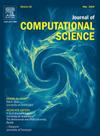An improved local radial basis function method for pricing options under the time-fractional Black–Scholes model
IF 3.7
3区 计算机科学
Q2 COMPUTER SCIENCE, INTERDISCIPLINARY APPLICATIONS
引用次数: 0
Abstract
The time-fractional Black–Scholes model (T-FBSM) is developed to assess price fluctuations in a correlated fractal transmission system. It is applied to price American and European call and put options on non-dividend-paying stocks. This study focuses on numerically solving the T-FBSM for option pricing using a local compact integrated radial basis function method (LCIRBFM). The temporal discretization is accomplished using the second-order shifted Grünwald scheme, while the spatial derivatives are discretized by using a combination of an integrated RBF interpolation and a compact scheme within a sub-domain (stencil). This approach utilizes second derivatives and nodal function values to construct a link between the RBF weights and the physical domain. The convergence and unconditional stability of the semi-discretized time formulation are proven via the energy method in the space. The proposed method demonstrates efficiency, and the numerical results validate the theoretical formulation.
时间分数Black-Scholes模型下期权定价的改进局部径向基函数方法
建立了时间分数Black-Scholes模型(T-FBSM)来评估相关分形传动系统的价格波动。它适用于美国和欧洲非派息股票的看涨和看跌期权定价。本文采用局部紧致积分径向基函数法(LCIRBFM)对期权定价中的T-FBSM问题进行了数值求解。时间离散化采用二阶平移grnwald格式,空间导数离散化采用集成RBF插值和子域内压缩格式相结合的方法。该方法利用二阶导数和节点函数值在RBF权重和物理域之间建立联系。利用能量法在L2空间中证明了半离散时间公式的收敛性和无条件稳定性。该方法的有效性得到了验证,数值结果验证了理论公式的正确性。
本文章由计算机程序翻译,如有差异,请以英文原文为准。
求助全文
约1分钟内获得全文
求助全文
来源期刊

Journal of Computational Science
COMPUTER SCIENCE, INTERDISCIPLINARY APPLICATIONS-COMPUTER SCIENCE, THEORY & METHODS
CiteScore
5.50
自引率
3.00%
发文量
227
审稿时长
41 days
期刊介绍:
Computational Science is a rapidly growing multi- and interdisciplinary field that uses advanced computing and data analysis to understand and solve complex problems. It has reached a level of predictive capability that now firmly complements the traditional pillars of experimentation and theory.
The recent advances in experimental techniques such as detectors, on-line sensor networks and high-resolution imaging techniques, have opened up new windows into physical and biological processes at many levels of detail. The resulting data explosion allows for detailed data driven modeling and simulation.
This new discipline in science combines computational thinking, modern computational methods, devices and collateral technologies to address problems far beyond the scope of traditional numerical methods.
Computational science typically unifies three distinct elements:
• Modeling, Algorithms and Simulations (e.g. numerical and non-numerical, discrete and continuous);
• Software developed to solve science (e.g., biological, physical, and social), engineering, medicine, and humanities problems;
• Computer and information science that develops and optimizes the advanced system hardware, software, networking, and data management components (e.g. problem solving environments).
 求助内容:
求助内容: 应助结果提醒方式:
应助结果提醒方式:


